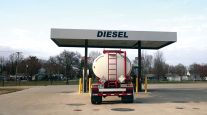Diesel Inches Up to $2.231
This story appears in the May 25 print edition of Transport Topics.
The national diesel fuel average rose 1.5 cents a gallon last week, while gasoline posted a much larger 6.9-cent jump, widening the gap between the two fuels as gas stockpiles declined ahead of the traditional Memorial Day start of summer driving season.
Although fuel prices have been generally rising in recent weeks, the price of crude oil has risen more dramatically than diesel or gasoline. Oil closed at $62.04 a barrel on May 20 in trading on the New York Mercantile Exchange, 82% higher than its price as recently as Feb. 12, when a barrel went for $33.98.
The average price of trucking’s main fuel last week was $2.231 a gallon in the Department of Energy’s May 18 survey of fueling stations, up from $2.216 on May 11. Gaso-
line stood at $2.309, an increase of 23.1 cents a gallon in two weeks, according to DOE’s Energy Information Administration.
Despite the low level of fuel prices compared with the peak hit in July 2008, last year’s events have left marks on the way fleet managers operate.
“We measure the use of [fuel] every day with every truck,” said Sharil Hardy, vice president of operations for Freymiller Inc.
The company is a refrigerated truckload carrier with 300 power units based in Oklahoma City, and Hardy said fuel has a major effect on Freymiller’s tractor purchases.
“We try to keep our trucks new, and we measure engines against each other,” Hardy said, adding
that the company is looking at Freightliner tractors in addition to its traditional Kenworths and Peterbilts. Assessing engines for fuel economy will play a major role in the comparison, she said.
Freymiller also has been spec’ing engines for a better match with the work the company has to do.
Petroleum markets last week were affected by supply disruptions ranging from Nigeria to Canada and the United States.
Reports of political unrest in Nigeria, which produces a light, sweet crude well-suited to the manufacture of ultra-low-sulfur diesel, coupled with a fire at Sunoco’s Marcus Hook, Pa., refinery, drove the price of oil to its highest level since Nov. 10.
The price of crude retreated, though, after the Federal Re-serve said the economy’s rate of decline was slowing but still declining and facing challenges. Crude fell to around $60 a barrel before closing at $61.05 on May 21.
Although fuel prices have been rising, the Energy Department said May 20 that U.S. refineries are running at a low level of capacity, 81.8% on May 15, down from 85.3% two weeks before.
On May 21 Royal Dutch Shell said its Scotford, Alberta, refinery would be shut down temporarily for maintenance.
In the May 11 Energy Department survey, the average price of regular gasoline topped the cost of diesel for the first time since 2007 (clcik here for previous story). The price gap between the two fuels widened to 6.8 cents a gallon from 2.4 cents on May 11.
The Energy Department’s May 20 This Week in Petroleum report said such a relationship between the two products used to be the typical pattern.
With winter over, the demand for home heating oil declines, meaning more middle distillate oil can be devoted to diesel fuel. At the same time, gasoline demand usually increases as people spend more time driving in the summer. The demand pattern reverses in the fall and winter, with diesel usually costing more than gasoline in those months.
However, the Department’s report said the old relationship began to break down in 2005 because of strong worldwide demand for diesel fuel.
But with the economies of many nations in disarray, demand for diesel has fallen. U.S. stocks of ultra-low-sulfur distillates, used for making diesel, have climbed 30% over the past year. Distillate inventories stood at 87.8 million barrels on May 15 — the largest since ULSD became the national fuel standard at the start of 2007. A year ago, the stockpile was 67.4 million barrels.
Gasoline stocks have moved in the other direction, falling nearly 4% to 204 million barrels on May 15, from 212.4 million on May 1.
On a regional basis, New England and the central Atlantic states had the nation’s most expensive diesel in the May 18 survey, at $2.401 and $2.396 a gallon, respectively. The 15 states in the Midwest had the cheapest fuel, at an average of $2.17.




